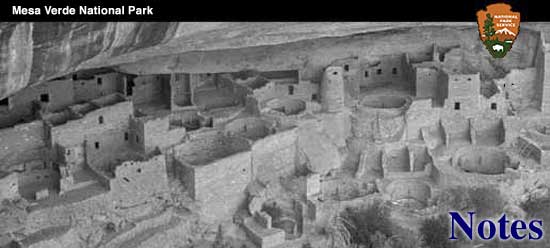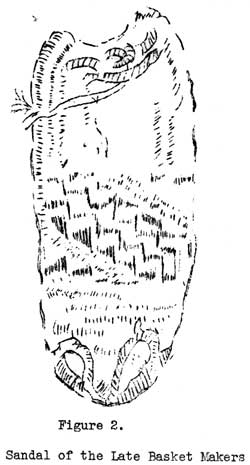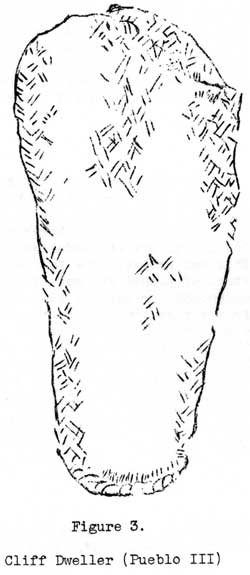

|
Although many hundreds of sandals have been taken from the ruins of the MESA VERDE there has been very little mention of them made in the few reports which have been put out on the region. Nordenskiold1 pictures a few of the best specimens which he obtained but told very little about them. Fewkes2 who did considerable excavation work here some years later describes a sandal taken from Cliff Palace. Earl Moris3 describes specimens from the region to the south of Mesa Verde Park-The Johnson Canyon region. These references constitute all the recorded work done on Mesa Verde type sandals. However, there are several very fine specimens in the Mesa Verde Museum on which this article is based.
It was found by these early workers in this region and also those in other parts of the Southwest, that a sequence or relative chronology could be made from the type of sandal found: that is, that people of the different periods of Southwestern archaeology made different kinds of sandals. Long ago these ancient inhabitants had learned that a foot covering was essential in the many miles of travel every day in search of the necessities of life. Hence they cultivated the art of sandal making.
From the very earliest times of which we have record, sandals were made basically of yucca leaf, whole, split or from its fibers. Both the narrow and broad leafed yucca leaves were used in their manufacture. Apocyuum fiber and juniper bark were sometimes used as a filler or weft between the warp of yucca cord. In late Pueblo times cotton rags were occasionally used as filler. This, of course, is description based on the Southwest in general. In the Mesa Verde region we know of very few sandals from the Basket Maker periods. This does not mean that these people did not make sandals. On the contrary they must have made a great many, but there is much work yet to be done here to find them, and those which have been taken out during excavation are to be found in museums from Mesa Verde to Finland with little or no record of where they were found or under what circumstances. The Basket Maker II sandal is the earliest type known to archaeologists in the Southwest. Only one of this type (Fig. 1) has been found in the Mesa Verde. While removing the debris from beneath the huge leaf rock upon which the speaker Chiefs House rests, in Cliff Palace preparatory to putting supports of cement beneath it this early type of sandal was uncovered. It was found many feet beneath the floor level of the latest houses left there by a people who had antidated the Cliff Dwellers by centuries. This particular Basket Maker II sandal was probably made very late in the period as it has some characteristics of Basket Maker III sandals. It is woven similar to sandals of the Basket Maker III period, but retains the square heel characteristic of the Basket Maker II period. The design similar to the Basket Maker III types consists of two parts, each of three parallel lines of dyed yucca cord used as weft. The toe which should be the deciding factor between the two periods is absent; so it remains for a similar one to be found before we will be certain as to what period this sandal belongs. 
Nordenskiold pictures one late Basket Maker sandal of the crescent or scalloped toed type from Step Rouse Cave. Another sandal of this type is now in the Mesa Verde Museum (Fig. 2). The warp is generally composed of about twenty-five hard woven yucca cords and the weft is of a fine yucca cord well battened down to produce an extremely tough and durable bootgear. This type of sandal is always decorated in one or more of several different ways. First, additional pieces of weft may be woven in to produce, geometric designs—second, pieces of dyed weft were often woven into designs and third, designs were painted on the sandal after completion. The finest sandals of any prehistoric period were produced in late Basket Maker times.

The greatest number of sandals have come from the Pueblo Periods. A decadence set in at the end of the Basket Maker period in the art of sandal weaving. This was probably due to a new stock of people who made their appearance or perhaps the change from a basket-making culture to a pottery-making culture was the cause for the decline. The change, however, did not take place rapidly because well made sandals are found holding over into early Pueblo times, but a change in shape and technique occurs. The Pueblo period sandals were not as carefully or elaborately made as the earlier types. Instead of using the yucca cord and fiber they began to use the leaves of the yucca plant. Occasionally some sandals of this period are found which are made of the yucca cord and fiber, but these are rare. In many cases the narrow leafed yucca was used in its natural state, or the broad leafed yucca by splitting the leaf into a number of strips. The method of weaving was to plait or twill (Fig. 4) these strips into the desired shape. 
Although sandals of the early pueblo periods have not been found in the Mesa Verde it does not necessarily mean that there were none of this period. It is hoped that sometime in the future when more excavation has been done that some specimens of this type will be found. Sandals belonging to the Pueblo III period are very numerous. Four varieties were made by the Cliff Dwellers of this region, the most common type (Fig. 3) being finely plaited of either whole leaves of the narrow leafed yucca or split leaves of the broad leafed yucca. These were woven by the over-two under-two or diagonal weave similar to the common basket weave. As to shape they follow the outline of the individual foot very closely. The toe jog or off-set was very common at this time. The sandal ties are very complex in comparison to those of earlier times and have been described in a previous issue of Mesa Verde Notes5
One such sandal was covered with a padding of juniper bark between the foot and the ties. A second type of this period is one well made of yucca cord very similar in weave to the crescent toad sandal of Basket Maker III times. It was a very intricate raised design on the sole made by inserting extra pieces of cord into the weave. A third type of sandal was made of yucca cords about one eighth of an inch in thickness woven in the diagonal weave, exactly like those woven of strips of the yucca leaf. This particular example also has the jogged toe and foot shape typical of the Pueblo III period. A fourth type was made either of broad strips of the broad leafed yucca or whole leaves of the narrow leafed yucca. It is very crude in comparison to the other types of sandal, but probably was very serviceable to the wearer. Because of its crude manufacture this type does not show the jog or offset. Nordenskiold during his excavation at Step House Cave found one that was made of the broad leafed yucca covered on the upper side with maize leaves to protect the foot of the wearer. In conclusion-we find that before a concise or clear cut sandal chronology for the Mesa Verde region can be set up several existing gaps must be filled in. Leaving the Mesa Verde region we find that an excellent work on this particular type of artifact, the sandal, was done by Kidder and Guernsey described in their publication on the artifacts found in the caves of Northeastern Arizona. Byron Cummings who worked in the same region at about the same time, reaches the same conclusions as Kidder and Guernsey.
-oOo- | ||||||
| <<< Previous | > Cover < | Next >>> |
vol5-2b.htm
14-Oct-2011